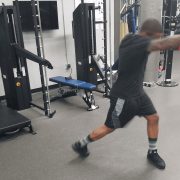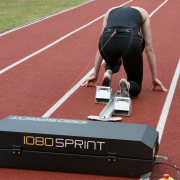The kinetics of a 20-meter sprint may tell a coach more about an athlete’s ability than just their speed. Drs. Jeremy Townsend and Gerald Mangine used the 1080 Sprint to parse a 20-meter sprint and correlate the power, force and velocity to other assessment exercises with collegiate basketball players.
Selecting exercises that efficiently and faithfully reflect an athlete’s ability in a sport is an important task for strength and conditioning coaches. Whether they are holding a combine, pre-season assessments or mid-season check-ins, coaches need these snapshots of an athlete’s fitness.
Determining the assessment exercise is only the first step. The coach must then determine what elements of that exercise truly matter for the sport. Limitations in data collection can constrain this step, reducing the usefulness of the test.
Sprinting is an important component of many field and court sports. However, rarely does an athlete merely sprint during competition. They have to cut, turn, dribble, swing and any number of other movements that interfere with their linear speed. Their speed in a 20-, 30- or 40-meter dash speaks only generically to how they will bring their sprinting ability to bear in a competition.
The 20-meter sprint is a common assessment tool in basketball, as it is two-thirds the length of the court. Rarely, though, does an athlete sprint 20 meters in a straight line with her attention focused ahead.
Townsend et al designed their study on the isometric mid-thigh pull (IMTP) as a measure of peak force and rate of force development. In addition to comparing the players’ output on the IMTP to basketball-relevant performance tests, they examined the relationship between IMTP and measures of power, force and speed using the 1080 Sprint over 20 meters.
READ THE STUDY: Journal of Strength and Conditioning Research (via ResearchGate)
The researchers examined the 1080 Sprint output in 5-meter segments, and the IMTP rate of force development in 50 millisecond segments for the first 250 milliseconds of the test.
They found large inverse relationships between IMTP peak force and sprint times. They also noted a moderate-to-large relationship between the IMTP rate of force development from 50-250 ms and average force and power in the first 5 meters of the sprint. Likewise, the average force, power and velocity over the full 20 meter sprint related to the rate of force development from 100-150 ms. There was a gap in the relationship between the sprint kinetics at 10 and 15 meters and the IMTP rate of force development. The researchers speculate that this could be due to the musculature involved in the different stages of the tests.
The relationship between the first five meters of a 20-meter sprint and the isometric mid-thigh pull rate of force development may be the most relevant to strength and conditioning coaches. Basketball players will perform many more 0-5 meter sprints than 20 meter sprints. Their ability to accelerate over those first few steps frequently impacts their performance on the court. Training an athlete to be more powerful in those first few steps is a specific and relevant goal.
The data from the 1080 Sprint shows how the broad 20-meter sprint test masks some of the most important information. The first 5 meters are the most important, as an on-court skill and for making the connection to the IMTP. Additionally, the kinetic data – power and force – are more telling than simply time.
This study shows how the IMTP is a valid training and testing exercise for basketball players. Because the IMTP relates so strongly to sport-specific measurements, coaches can use the IMTP to make their assessment process more efficient and less stressful on the athlete.









































































